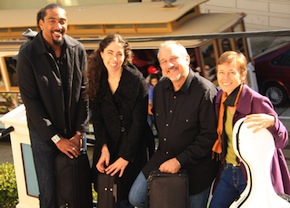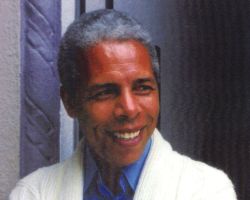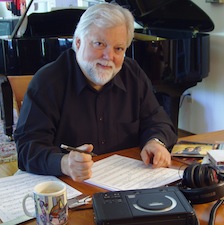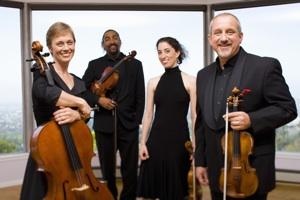Music and Immigration:
This is the third article in an ongoing series.
Read Part I and Part II
Expatriates in the U.S. often long for the cultures that nurtured them and their musical expression. As immigrants find new sounds in their new home, the sounds back in their old home are also evolving. This series explores the manner in which music helps relocated musicians to bridge cultures, and how that process changes both them and the music itself.

Featured Video
He’s made a mission of “expanding the horizons of the string quartet,” but violinist Jeremy Cohen was surprised by his discovery of a “very unique sense of place” in the African islands of Cape Verde and their expatriate composer Amandio Cabral. Cohen and his Quartet San Francisco (QSF) will be joining pianist and arranger Larry Dunlap and his jazz quartet, as well as the visiting Cape Verdean vocalist Gabriela Mendes, in a concert of songs by Cabral, at Yoshi’s San Francisco on Sept. 19.
The event is a case study in cross-genre pollination in a benign setting of collegial respect and friendship. Cabral, who from an early age has been a singer and guitarist in indigenous Cape Verdean styles, came to the states on a cultural exchange program in the mid-1960s. Dunlap, who’d begun playing jazz as a middle schooler in Forest Grove, Ore., arrived in San Francisco a decade later, and encountered both his future wife and collaborator Cabral in local jazz clubs.
Another decade passed, and Cohen, classically trained and a former student of Itzhak Perlman and Anne Crowden, decided to return from Los Angeles to the Bay Area, where he was raised. He was advised to recruit Dunlap as both an arranger and a performer in his upbeat Violinjazz band. Although Cohen and QSF cellist Michelle Djokic have recorded some of Cabral’s songs with Dunlap, this will be the first time they’ll have performed that music in a live concert setting.
The Morna Goes Off-Island
Before they met Cabral, neither Dunlap nor Cohen had heard a morna, the mournful Cape Verdean ballad form in which Cabral invests his melodies and lyrics (in both Portuguese and the Kriolu dialect). In fact, few in our country knew anything about the sounds of the tiny archipelago nation, situated about halfway between Portugal and Brazil, and evocative of those countries’ song forms (Portugal’s fado and Brazil’s choro), until the eponymous American release in 1995 by Cesária Évora, which included several songs by Cabral. Évora, a cigarette-smoking, whiskey-tippling grandmother with the innocent yet seductive, dusky voice of a teenager, bolstered her widespread popularity with subsequent recordings and American tours, including near-sellout performances at Berkeley’s Zellerbach Hall, courtesy of Cal Performances. In an interview before one of these, she shared youthful memories of Cabral, six years her senior, as one of the few of her fellow countrymen heard singing on the radio.
“It was probably not until 1990 or so that Amandio introduced me to recordings and I started hearing the rhythmic things they did in mornas.” — Larry Dunlap
“In Cape Verde, we don’t take the artist’s life seriously,” says Cabral, now a septuagenarian resident of San Francisco’s North Beach district. He recalls witnessing the young Évora’s first forays into morna, previously the province of male singers, in the informal settings of bars on the island of São Vicente. Cabral, like Évora, had learned to sing in church, but “the church had rules about singing, as well as drinking and smoking, and I didn’t really pick any of that up until my mother left for Senegal, when I was 16 or 17. Then I could do whatever I wanted to do.”

Although Cape Verde supported several other song forms, some of them faster and danceable, Cabral and Évora both sought in morna the expression of sodade, an untranslatable but blueslike quality also found in fado and choro, which Cabral describes as “like you are missing someone, or missing a place.” In all those song forms, and in much of the music of Spain and of Spanish and Portuguese colonies, the melancholic tinge bears vestiges of Middle Eastern modes, exported along with stringed instruments to the Iberian Peninsula by the invading Moors, 13 centuries ago.
“When I first heard [Cabral’s] music, it kind of sounded like Brazilian music, the harmonies and rhythms, which I was already familiar with,” recalls Dunlap, pointing to what the Brazilians refer to as saudade in their own music. “It was probably not until 1990 or so that Amandio introduced me to recordings of Cesária and others, and I started hearing the rhythmic things they did in mornas, the way they would bend notes and have delayed phrasing, and a lot of things in the lower instruments, chromatic runs up the bass notes.”
An Immigrant Immerses Himself in Jazz, but Slowly
When he was still a recent immigrant, Cabral was slow to embrace the music that had grown legendary in the clubs of his new North Beach neighborhood. “I knew nothing about jazz, and jazz disturbed me,” he admits. “It was very confusing to me. But then I went to hear [jazz pianist and composer] Horace Silver — his father comes from Cape Verde. And I listened to great musicians at Keystone Korner [formerly on Vallejo Street].”He began auditing music theory classes at San Francisco State College. And by the time he met up with Dunlap, Cabral was managing Peta’s, a club on Columbus Avenue, and hosting local jazz artists there. It was the first venue where Dunlap and his wife-to-be, vocalist Bobbe Norris, performed together.
As Dunlap began to record Cabral’s music (amounting to 10 discs, most on Cabral’s COIT label and not all released), the songwriter encouraged his pianist/arranger friend not to be bound by Cape Verdean conventions, “because it’s been played and played and played for years, the same thing.” “It’s maybe a little more sophisticated, because I put in jazz harmonies, and things I’ve heard in Brazilian music,” says Dunlap about his arrangements. “And some of the rhythmic things I do are a combination of jazz and Brazilian and Cape Verdean, but don’t sound strictly like any of them.”
“Cape Verdean music has changed. And I think it’s because of Larry. When Larry record my music, he made it more contemporary.” — Amandio Cabral
Cabral sent copies of his recorded collaborations with Dunlap back to his homeland, and he’s noticed, in the last few decades, that, “Cape Verdean music has changed. And I think it’s because of Larry. When Larry record my music, he made it more contemporary. At first, I had a lot of criticism from Cape Verdeans, my own people. But then, things began to change a little bit, and today, when I get CDs from home, I say, ‘Larry, listen to this!’”
Recruiting string players from the Quartet San Francisco for the Yoshi’s engagement was partly Cabral’s idea. “Cape Verde has a great history of violin players, and it’s like gypsy violin,” he notes. As with Dunlap, QSF’s Jeremy Cohen had gotten to know Cabral before he found out much about his musical output. “Amandio is a music lover first, and how many people can you say that about?” Cohen asks rhetorically. “This is a guy that heard about QSF gigs, and even when I didn’t comp him in, he was there. He was always a great fan, always down for the hang.” Now that he’s becoming familiar with Cabral’s compositions, Cohen finds that “There’s a meditative element to it, but it’s not narrow in terms of the changes. It’s very jazz-influenced, the music goes places, yet there’s a large sense of calm and relaxation.”
Fitting Traditions and Styles Together

Dunlap thinks the upcoming Yoshi’s gig “is making my brain work,” having to expand from basic arrangements of Cabral’s songbook to the scope of a string quartet, his own three-piece rhythm section, and a woodwind player. Yet he’s previously proven his skills, as orchestrator and arranger for the Marin Opera and for San Mateo Civic Light Opera and advisor to classical composer Gordon Getty on the latter’s Plump Jack project. He’s also worked on operatic repertoire with jazz singer Cleo Laine, and cabaret repertoire with operatic soprano Patricia Racette. And he’s an erudite creator of “fake books,” the voluminous compendiums of melodies and solos that are invaluable to jazz instrumentalists and singers.
Flying in for the gig from Cape Verde with her 15-year-old son will be 38-year-old vocalist Gabriela Mendes. None of the local musicians are acquainted with her, but from the limited evidence of recordings and YouTube clips, “I like her singing very much and I think it will fit Amandio’s music well,” says Dunlap. “She’s very straightforward, and she doesn’t try to be flashy with the songs. Her singing has a lot of ethnic qualities, and you can also sense a real intelligence there. She speaks English very well.” “And,” Cabral interjects, “she’s a very handsome woman.”
“I’ve been listening to Gabriela, to get a sense of what we’ll be playing with, and I just found myself grooving to the music,” adds Cohen. “It’s an almost physical sensation, an arrest of all the madness that can occur with daily life. She’s a terrific talent, and a beautiful lady.”
Mendes has indicated that she may know more about Cabral and Dunlap than they know about her, and there’s evidence that the pair’s reputation has spread to her fellow countrymen. “There’s a man over there who’s trying to book a tour for us,” says Dunlap. “He said his dream, for many years, has been to bring me and Amandio to Cape Verde, to do some concerts.” Cabral no longer concertizes, after a recent stroke, “but people over there would be thrilled just to see him.”
For those discovering Cabral at Yoshi’s, or renewing their acquaintance, “it’s gonna have a completely unique and special feeling,” Cohen promises. “It’s the kind of thing people go out and experience, and then remember for a long, long time.” That memory will be made more lasting by a gathering of all the performers later in the week at Fantasy Studios in Berkeley, to record an album. “Some of the songs will be new, but I wrote most of them in the 1950s,” says Cabral. “That’s why I want to leave some kind of legacy, because I’m 76 years old, and, anytime now ...” After a pause comes a chuckle and a smile.

